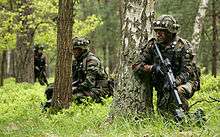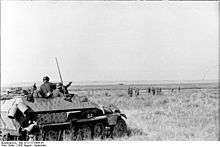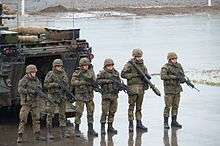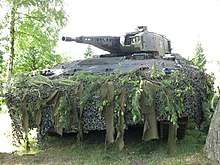Panzergrenadier
Panzergrenadier (![]()

Additionally, in the German Army, Panzergrenadier (Pzg) is also the lowest rank of enlisted men (Mannschaften) in the Panzergrenadiertruppe, comparable to NATO Other Rank-1 level.
Forerunners
The term Panzergrenadier was not adopted until 1942. Infantry in panzer divisions from 1937 onwards were known as Schützen Regiments; they wore the same rose pink piping on their uniforms as the tank crews (with an "S" cypher that distinguished the Schützen from the tank and anti-tank units that also wore that colour). Soldiers in special Motorized Infantry units wore the standard white piping of the Infantry. In 1942, when Infantry Regiments were renamed as Grenadier Regiments by Hitler as a historical homage to Frederick the Great's Army, the Schützen regiments (and the soldiers in them) began to be redesignated as Panzergrenadier regiments, as did Motorized Infantry units and soldiers. Their Waffenfarbe was also changed from either white (in the case of Motorized Infantry) or rose pink to a meadow-green shade previously worn by motorcycle troops. Some units did not change over their designations and/or Waffenfarbe accoutrements until 1943, and many veteran Schützen ignored regulations and kept their rose-pink until the end of the war.
World War II usage

The term Panzergrenadier had been introduced in 1942, and was applied equally to the infantry component of Panzer divisions as well as the new divisions known as Panzergrenadier Divisions. Most of the Heer's PzGren. divisions evolved via upgrades from ordinary infantry divisions, first to Motorized Infantry divisions and then to PzGren. divisions, retaining their numerical designation within the series for infantry divisions throughout the process. This included the 3rd, 10th, 14th, 15th, 16th, 18th, 20th, 25th, and 29th divisions. Others, such as the Großdeutschland Division, were built up over the course of the war by repeatedly augmenting the size of an elite regiment or battalion. The Waffen-SS also created several PzGren. divisions by the same methods, or by creating new divisions from scratch later in the war. A number of PzGren. divisions in both the Heer and Waffen-SS were upgraded to Panzer divisions as the war progressed.
The Panzergrenadier divisions were organized as combined arms formations, usually with six battalions of truck-mounted infantry organized into either two or three regiments, a battalion of tanks, and an ordinary division's complement of artillery, reconnaissance units, combat engineers, anti-tank and anti-aircraft artillery, and so forth. All these support elements would also be mechanized in a PzGren. division, though most of the artillery, anti-tank, and anti-aircraft elements were equipped with weapons towed by trucks rather than the relatively rare armored and self-propelled models. In practice the PzGren. divisions were often equipped with heavy assault guns rather than tanks, one armoured regiment with three battalions of 14 assault guns each one of them[1] due to a chronic shortage of tanks throughout the German armed forces. A few elite units, on the other hand, might have the tanks plus a battalion of heavy assault guns for their anti-tank element, and armored carriers for some of their infantry battalions as well.
On paper a Panzergrenadier division had one tank battalion less than a Panzer division, but two more infantry battalions, and thus was almost as strong as a Panzer division, especially on the defensive. Of 226 panzergrenadier battalions in the whole of the German Army, Luftwaffe and Waffen SS in September 1943, only 26 were equipped with armoured half tracks, or just over 11 percent. The rest were equipped with trucks.[2]
List of World War 2 Panzergrenadier divisions
- 3rd Panzergrenadier Division
- 10th Panzergrenadier Division
- 15th Panzergrenadier Division
- 16th Panzergrenadier Division
- 18th Panzergrenadier Division
- 20th Panzergrenadier Division
- 25th Panzergrenadier Division
- 29th Panzergrenadier Division
- 90th Panzergrenadier Division
- 233rd Panzergrenadier Division
- Panzergrenadier Division Brandenburg
- Panzergrenadier Division Feldherrnhalle
- Panzergrenadier Division Großdeutschland
- Fallschirm-Panzergrenadier Division 2 Hermann Göring (Luftwaffe)
- SS Panzergrenadier Division Leibstandarte SS Adolf Hitler
- 3rd SS Panzergrenadier Division Totenkopf
- 4th SS Polizei Panzergrenadier Division
- 9th SS Panzergrenadier Division Hohenstaufen
- 11th SS Volunteer Panzergrenadier Division Nordland
- 16th SS Panzergrenadier Division Reichsführer-SS
- 17th SS Panzergrenadier Division Götz von Berlichingen
- 18th SS Volunteer Panzergrenadier Division Horst Wessel
- 23rd SS Volunteer Panzergrenadier Division Nederland
- 28th SS Volunteer Panzergrenadier Division Wallonien
- 38th SS Panzergrenadier Division Nibelungen
Equipment
The use of armoured half-tracks was rare in the German Army, and even the elite Großdeutschland Division, with two panzergrenadier regiments, only mustered a few companies' worth of the vehicles, generally Sd.Kfz. 251 troop carriers. The vast majority of Schützen/Panzergrenadier soldiers were mounted in trucks. Additionally, vehicles in the early war period suffered from poor off-road performance.
In 1944 a couple of Panzer Divisions based in France had more than the standard one battalion mounted in Sd.Kfz. 251 troop carriers. The Panzer Lehr Division's infantry and engineers were entirely mounted in Sd.Kfz. 251 troop carriers, while the 1st Battalion in both Panzergrenadier regiments in 2. Panzer Division and 21. Panzer Division were half-equipped with armoured halftracks (Sd.Kfz. 251 troop carriers for 2. Panzer, U304(f) light armoured personnel carriers for 21. Panzer).
Post-WWII
Bundeswehr

Missions and concepts
In the German army, Panzergrenadiere act as mechanized infantry and escort for tanks and other armoured fighting vehicles.
According to the German central army regulation HDv 100/100 (State of 2000), the Panzergrenadiertruppe and their co-operation with other armoured troops is characterized as following:
The Armoured military forces consist of the Panzertruppe and the Panzergrenadiertruppe. [...] Due to the mobility and protection offered by their armoured fighting vehicles, the Panzergrenadiertruppe is especially suited for swift changes between mounted and dismounted combat to maintain the momentum of armoured troops. [...] The direct and close cooperation of the Panzertruppe and the Panzergrenadiertruppe is, next to the cooperation with Combat support, mandatory to succeed. Their versatility and reactivity enables them to gain and maintain the initiative and bring about the decision.[3]
According to the HDv 231/100, the fighting of a Panzergrenadier-Battalion is characterized by the following aspects:
"The fighting of the battalion is characterized by:
- the combination of fire and movement,
- attacking in conjunction with main battle tanks,
- swift changes between mounted and dismounted combat,
- close cooperation between mounted and dismounted forces,
- the particularly mobile combat, [...]"[4]
Bundeswehr Panzergrenadier units
After the newest phase of the transformation process the German Army will be fielding the following active Panzergrenadier battalions:



.jpg)

.jpg)



.jpg)

.jpg)
Additionally, in 2008 two inactive Panzergrenadier Battalions were formed:
- Panzergrenadierbataillon 908, Viereck (with Panzergrenadierbataillon 411 as supplying and maintaining unit)
- Panzergrenadierbataillon 909, Marienberg (with Panzergrenadierbataillon 371 as supplying and maintaining unit)
Training and development of the Panzergrenadiertruppe is usually performed by the Armoured Corps Training Centre (Ausbildungszentrum Panzertruppen) in Munster, its commander holding the title of General der Panzertruppen. Some essential training courses, especially for urban warfare and fighting in forested terrain, are held at the Ausbildungszentrum Infanterie ("Infantry Training Centre") at Hammelburg.
Operators
Austria
The two existing Panzergrenadier battalions of the Austrian Bundesheer use the Ulan armoured fighting vehicle.[5] The Waffenfarbe of the Austrian Panzergrenadiers is black.
Germany
The main weapon system of the German Panzergrenadiers is the Puma IFV. It was introduced beginning in 2010, with equipping to be completed by 2025.[6] Due to the design of the Puma, Panzergrenadiers cannot exceed a height of 1.84 meters.
The G36 assault rifle is the standard weapon of German infantrymen and also used by Panzergrenadier units. Each dismounted fireteam usually also deploys a MG3 machine gun. To fight armored vehicles or other hard targets the Panzerfaust 3 rocket-propelled grenade and the MILAN Anti-tank guided missile are in use. The MILAN-ATGM is used by dismounted Panzergrenadier fireteams (which consist of six soldiers due to the number of soldiers carried by the Marder and Puma IFVs), as well as attached to the Marder turret to provide the IFV with enhanced anti-armour capabilities. In tandem with the replacement of the Marder by the Puma, the MILAN is similarly being replaced by the Spike-ATGM for mounted and dismounted use.
As part of the Future Soldier-program, the German Infanterist der Zukunft-program is also intended to be introduced into Panzergrenadier-units and is already deployed with German soldiers in Afghanistan.
Notes
- La Guerre des Blindes, Eddy Bayer, Athens, 1964
- Panzergrenadier Divisions 1939–45 by Chris Bishop. London: Amber Books Ltd, 2007.
- HDv 100/100 Truppenführung (TF), state of 2000-12-15, Nr.233
- HDv 231/100 (zE), Das Panzergrenadierbataillon, state of 2001-03-01, Nr.1003
- Panzergrenadiere: Österreichisches Bundesheer
- "Press Release about the commission for series production" (PDF). Archived from the original (PDF) on 2009-08-15. Retrieved 2009-09-16.
- "Army Technology – CV 90". Retrieved 2008-09-17.